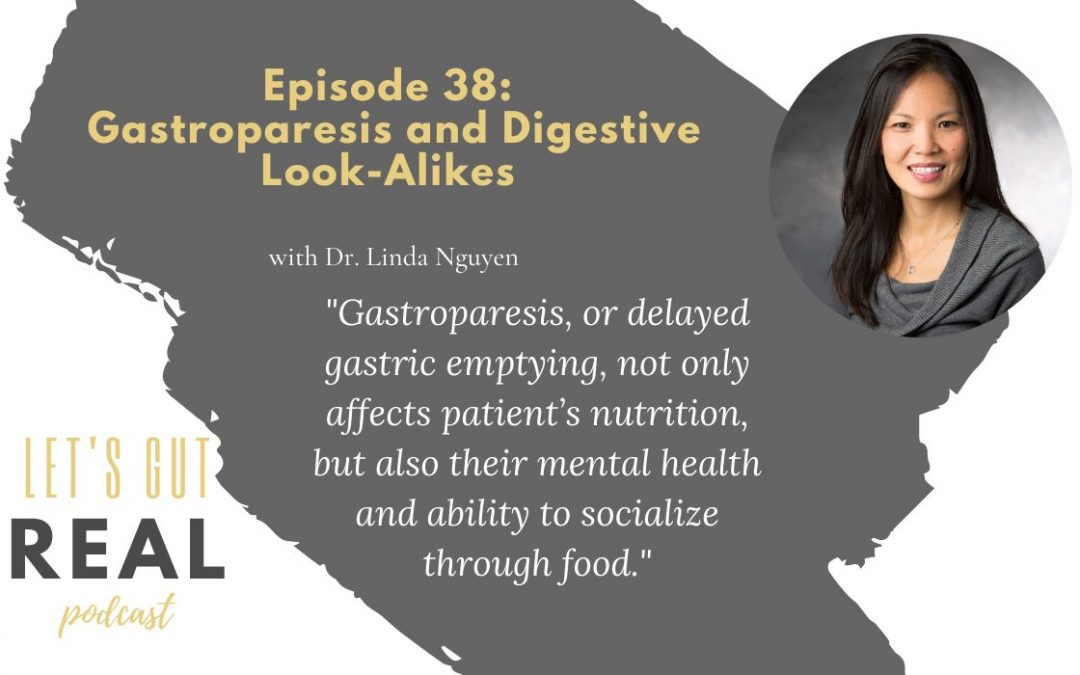Feeling full, nausea and vomiting are all symptoms of gastroparesis, yet other gut conditions can present like this too – so how do we know which it is? This week I interview Dr. Linda Nguyen on gastroparesis and other digestive disorder look-alikes like IBS, functional dyspepsia, cyclic vomiting syndrome and how she works with patients to improve their quality of life.
Nutrition Pearls for Gastroparesis and Digestive Look-Alikes
- Know that the most common cause of gastroparesis is idiopathic, followed by diabetes, surgery, and neurological diseases
- Know that recovery is possible in some patients with gastroparesis but there is currently no cure so it’s really about treating the symptoms
- Understand that for patients with GI disorders – It’s not just about the nutritional aspect of food – food is also an important part of how we socialize, and it is therefore important to strike a balance between quality of life and nutritional intake
- The most common symptoms of gastroparesis are nausea and vomiting – especially vomiting of undigested food hours later (as compared to vomiting food coming up immediately after eating). Other symptoms include upper and abdominal pain, and excessive fullness / early satiety with very small amounts of food
- Many patients with gastroparesis also present with constipation which can excacerbate symptoms – so managing constipation is key
- Consider multiple different approaches when aiming to manage gastroparesis like diet, food processing techniques, eating behaviours, going for walks after meals, medication management, and glycemic control
- Know conditions with overlapping symptoms, like functional dyspepsia and cyclic vomiting syndrome
- Consider the idea that gastroparesis and functional dyspepsia fall on a spectrum, with the two disorders being distinct but also having a lot of overlap between the two
Today I interviewed Dr. Linda Nguyen on digestive disorders with a focus on gastroparesis
Dr. Linda Nguyen is a Clinical Professor of Medicine at Stanford University and Clinic Chief in the Digestive Health Center. Her clinical and research interests include GI motility disorders and disorders of gut brain interaction, with an emphasis on gastroparesis, functional dyspepsia and chronic abdominal pain. Her current research includes identifying biomarkers to better diagnose motility disorders, understanding the role/impact of physiologic testing on clinical care, exploring novel therapies for gastroparesis and expanding the role of neuromodulation in the treatment of GI motility disorders and pain. She is also passionate about quality of life, professional development and physician wellness.
We talk about:
- How Linda came to work in the field of digestive health and her interest in GI motility and gastroparesis
- What gastroparesis is, how it develops, what the symptoms are, and how common it is
- The tests for gastroparesis
- How patients with gastroparesis develop a change in motility or emptying of their stomach
- Treatment options for gastroparesis
- Functional dyspepsia, how it similar or different from gastroparesis, and what the symptoms are
- Cyclic vomiting syndrome, how it similar or different from gastroparesis, and how is it treated / managed
- The use of implanted gastric stimulators for gastroparesis treatment
- The nutrition management of gastroparesis
You can learn from Dr. Nguyen on Twitter @LindaNguyenMD



Recent Comments